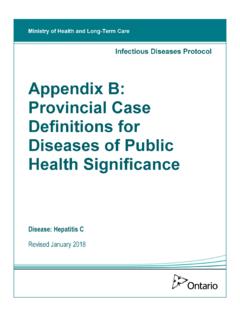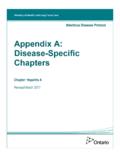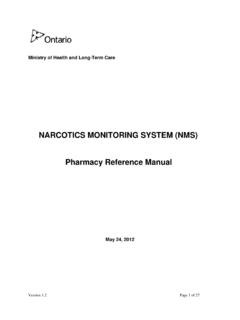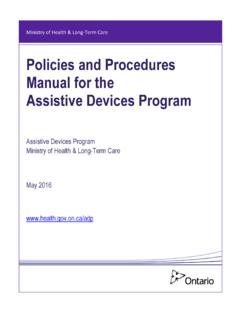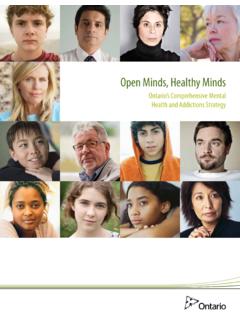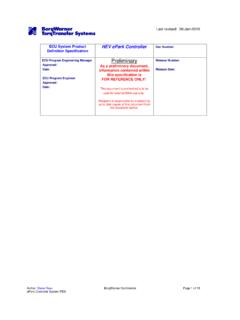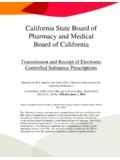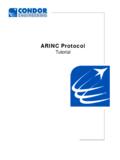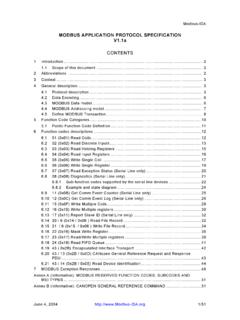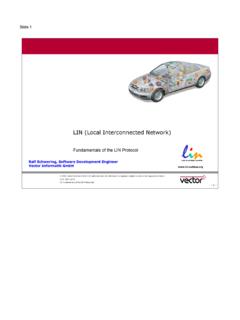Transcription of Tuberculosis Prevention and Control Protocol, 2018
1 Ministry of Health and Long-Term Care Tuberculosis Prevention and Control protocol , 2018 Population and Public Health Division, Ministry of Health and Long-Term Care Effective: January 1, 2018 or upon date of releaseTuberculosis Prevention and Control protocol , 2018 2 Preamble The Ontario Public Health Standards: Requirements for Programs, Services, and Accountability (Standards) are published by the Minister of Health and Long-Term Care under the authority of section 7 of the Health Protection and Promotion Act (HPPA) to specify the mandatory health programs and services provided by boards of ,2 The Standards identify the minimum expectations for public health programs and services. Boards of health are accountable for implementing the Standards including the protocols and guidelines that are referenced in the Standards.
2 Protocols are program and topic-specific documents incorporated into the Standards which provide direction on how boards of health shall operationalize specific requirement(s) identified within the Standards. Purpose The purpose of this protocol is to provide direction to boards of health to reduce the burden of Tuberculosis (TB) through Prevention and Control . To further support the clinical and public health management of TB cases and contacts, it is recommended that other published materials be utilized for further information, relevant definitions, and guidance, such as the most current version of the Tuberculosis disease-specific chapter of the Infectious Diseases protocol , 2018 (or as current), the Canadian Tuberculosis Standards, 2014 (or as current), and the Tuberculosis Program Guideline, 2018 (or as current).
3 3-5 Reference to the Standards This section identifies the standard and requirements to which this protocol relates. Infectious and Communicable Diseases Prevention and Control Requirement 1. The board of health shall conduct population health assessment and surveillance regarding infectious and communicable diseases and their determinants. These efforts shall include: a) Reporting data elements in accordance with the Health Protection and PromotionAct; the Infectious Diseases protocol , 2018 (or as current); the Rabies Preventionand Control protocol , 2018 (or as current); the Sexual Health and SexuallyTransmitted/Blood-Borne Infections Prevention and Control protocol , 2018 (or ascurrent); and the Tuberculosis Prevention and Control protocol , 2018 (or ascurrent);b) Conducting surveillance and epidemiological analysis, including the monitoring oftrends over time, emerging trends, and priority populations in accordance with theInfectious Diseases protocol , 2018 (or as current); the Population HealthAssessment and Surveillance protocol , 2018 (or as current); the RabiesPrevention and Control protocol , 2018 (or as current).
4 The Sexual Health andTuberculosis Prevention and Control protocol , 2018 3 Sexually Transmitted/Blood-Born e Infections Prevention and Control protocol , 2018 (or as current); and the Tuberculosis Prevention and Control protocol , 2018 (or as current); c) Responding to international, Federal/Provincial/Territorial and local changes in diseases epidemiology by adapting programs and services; and d) Using the information obtained through assessment and surveillance to inform program development regarding communicable diseases and other infectious diseases of public health importance. Requirement 11. The board of health shall provide public health management of cases, contacts, and outbreaks to minimize the public health risk in accordance with the Infectious Diseases protocol , 2018 (or as current); the Institutional/Facility Outbreak Management protocol , 2018 (or as current); the Management of Potential Rabies Exposures Guideline, 2018 (or as current); the Rabies Prevention and Control protocol , 2018 (or as current); the Sexual Health and Sexually Transmitted/ Blood-Borne Infections Prevention and Control protocol , 2018 (or as current); and the Tuberculosis Prevention and Control protocol , 2018 (or as current).
5 Requirement 12. The board of health shall facilitate timely identification of active cases of TB and referrals of persons through immigration medical surveillance in accordance with the Tuberculosis Prevention and Control protocol , 2018 (or as current) and Tuberculosis Program Guideline, 2018 (or as current), and shall provide or ensure access to TB medication at no cost to clients or providers. Operational Roles and Responsibilities Data collection and reporting of data elements 1) The board of health shall: General a) On an annual basis, advise health care providers who have a duty to report diseases under the HPPA (including physicians, nurses, pharmacists and optometrists), hospital administrators, superintendents of institutions, school principals, and operators of a laboratory about the requirement to report cases of Tuberculosis (TB), according to the b) Ensure that the information entered into the integrated Public Health Information System (iPHIS) or any other method specified by the Ministry of Health and Long-Term Care and/or Public Health Ontario ( ministry/PHO ) is complete and accurate and includes the final case disposition (see current iPHIS Guide Tuberculosis Module Section I to VII or any other guide specified by the ministry and/or PHO).
6 Tuberculosis Prevention and Control protocol , 2018 4 Confirmed and suspect cases c) Create a record for the person as a suspect or confirmed case in iPHIS or anyother method specified by the ministry/PHO within one business day of receivingthe initial information on cases d)Enter into iPHIS or any other method specified by the ministry/PHO all initiallaboratory (including drug sensitivities) and radiological reports withi n onebusiness day of r )Enter into iPHIS or any other method specified by the ministry/PHO any additionaldata elements as sp ecified in Regulation 569 (Reports), and the current iP HIST uberculosis ( TB) User Guide, as soon as p ossible, but i n any event no l ater than30 calendar days from the date of r ,7 Information for TB contacts f)Create a record for any suspected or confirmed contact and enter into iPHIS or any other method specified by the ministry/PHO, all demographics, episode status, and the link to the source cas e as soo n as possible, but n o later tha n 30 calendar days of identification of the )Enter into iPHIS or any other method specified by the ministry/PHO any additional data elements as soon as possible, but in any event no later tha n 30 calendar days of medical surveillance h) Enter into iPHIS or any other method specified by the ministry, the demographics(if client self -reported)
7 , episode status, and additional data elements, as outlined iniPHIS TB User Guide Section II: Medical Surveillance for persons onimmigration medical surveillance as soon as possible, but no later than 30calendar days of the person TB infection (LTBI) i) Enter all required data elements in accordance with the current iPHIST uberculosis (TB) User Guide into iPHIS or any other method specified by theministry/PHO as soon as possible, but in any event no later than 30 calendar daysof Prevention and Control protocol , 2018 5 Surveillance 2) The board of health shall on an annual basis: a) Conduct epidemiological analysis of TB data on, but not limited to, the following: i) For cases: Age Gender Risk factors Risk settings Clinical, laboratory and radiological findings Drug resistance Country of origin Proportion completing treatment Mortality ii) For LTBI in locally-identified high-risk groups: Age Gender Risk factors Risk settings Country of origin Proportion initiating treatment Proportion completing treatment b) Prepare a detailed summary of any outbreaks of TB occurring in its jurisdiction.
8 C) Disseminate relevant epidemiological analyses of TB data to relevant health care and community stakeholders. d) Utilize the results of epidemiological analyses of TB data, including outbreak summaries, for program planning. Early identification of TB cases, including referrals of persons with inactive TB through immigration medical surveillance 3) The board of health shall: Early identification of TB cases a) Implement strategies to promote the early identification and treatment of persons with TB. b) Provide annual education to health care providers and/or community stakeholders, as needed, based on local epidemiology, as outlined in the Tuberculosis Program Guideline, 2018 (or as current), about the following: i) Considering TB in persons with compatible symptoms; ii) Reporting suspect and confirmed cases of TB according to the HPPA;2 and Tuberculosis Prevention and Control protocol , 2018 6 iii) Screening of high-risk groups, as per the Canadian Tuberculosis Standards, 2014 (or as current).
9 4,5 Referrals for medical surveillance c) Have a process in place to prioritize timely initiation of medical surveillance for urgent referrals ( , clients required by Immigration, Refugees, and Citizenship Canada (IRCC) to report for medical surveillance upon arrival in Canada), as outlined in d), in accordance with minimum guidelines set in the Tuberculosis Program Guideline, 2018 (or as current) to: i) Locate these persons; and ii) Refer and facilitate the process for medical assessment of these persons upon receipt of the urgent notification or immediately if they have signs or symptoms of active TB. iii) Once active TB is ruled out continue to follow these persons as per Regular Immigration Medical Surveillance (see d) iii and d) iv).5d) Have a process in place for managing referrals for immigration medical surveillance ( , clients required by IRCC to report for medical surveillance), in accordance with minimum guidelines set in the Tuberculosis Program Guideline, 2018 (or as current), to: i) Contact these persons; ii) Conduct preliminary assessment for symptoms of active TB; iii) Provide TB education at first contact with these persons, which would include: Symptom recognition and the need to notify the board of health should symptoms occur; IRCC requirements of medical surveillance; Instructions for obtaining Ontario Health Insurance Program (OHIP) coverage; and Ava ilability of TB for Uninsured Persons Program (TB-UP) as required.
10 Iv) Facilitate medical assessment for active TB disease and/or LTBI, including laboratory and radiological testing as determined by the attending health care provider, according to the Tuberculosis Program Guideline, 2018 (or as current).5v) Utilize strategies to facilitate the early identification of active TB in individuals referred for medical surveillance ( , base follow-up on risk level, outlined in the Tuberculosis Program Guideline, 2018 (or as current)).5 Management of TB cases 4) The board of health shall, in accordance with relevant/applicable documents: a) Initiate contact with persons who have suspected/confirmed respiratory TB and their health care providers, within 24 hours of receipt of the notification. b) Direct the person to be in respiratory isolation if respiratory TB is suspected/confirmed.
